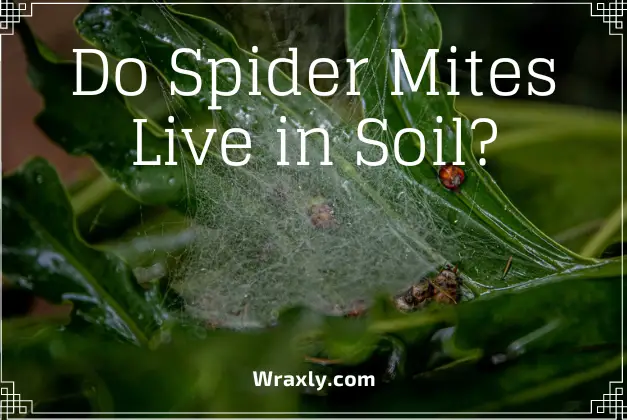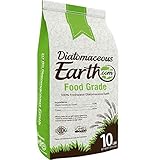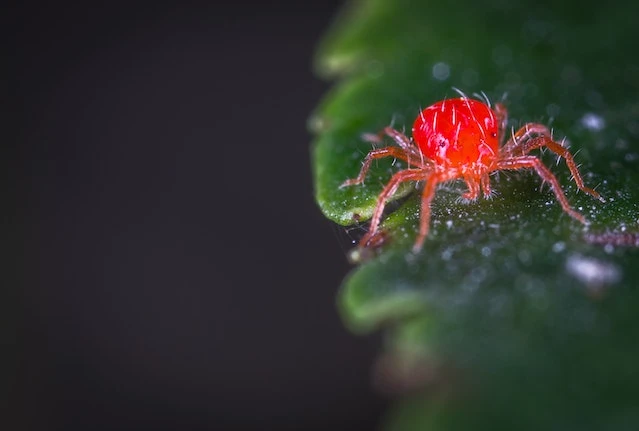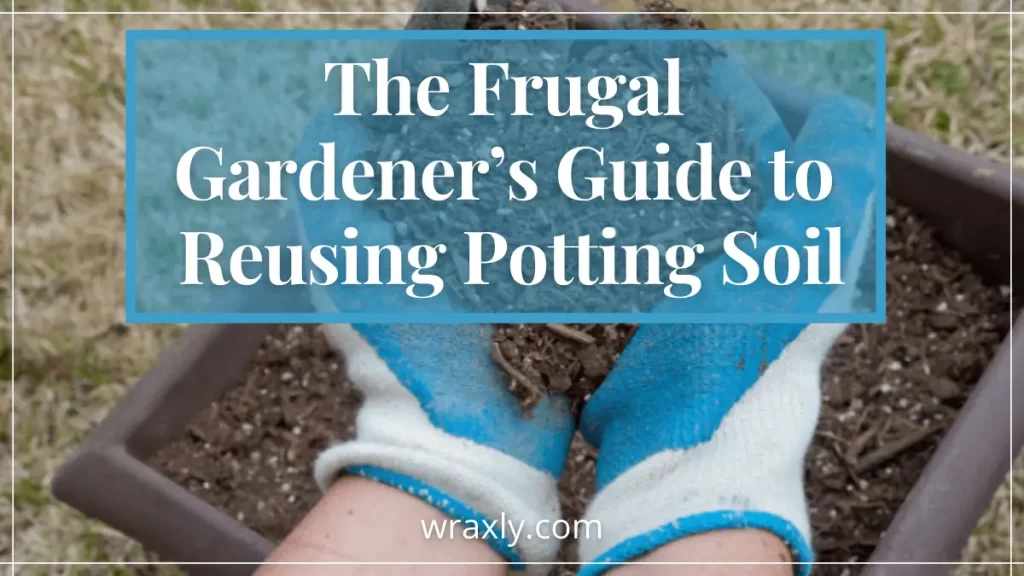Spider mites may not be visible to the naked eye, but their infestation can kill your beloved garden in a short amount of time. These little arachnids are common in plants and soil because these are parasites that live off the nutrients commonly found in dirt and plants.
Thus, it is better to prevent spider mites and identify them at an early stage to avoid any unavoidable damage to your plants.
Hopefully, our expertise on these sap-sucking creatures will help you get rid of them quickly and save your plants.

Do Spider Mites Live in Soil or on Plants?
To be honest, spider mites are more fond of living on plants than soil, but that doesn’t mean there is no possibility of them living in the soil. However, spider mites enjoy low humidity and arid dry soil and will live in it for days until they transfer to a plant.
Although spider mites in the soil are not common, you must take quick action to remove these insects. You can adopt many tactics to remove them, and with the proper one, you might get rid of them for good.
Don’t let your indoor or outdoor garden reach a detrimental state because of these mites.
How to Identify Spider Mites in Soil?
You won’t be able to easily identify spider mites in the soil because of their tiny size. But there are some signs which might help you determine whether there could be spider mites in the soil. For instance,
- Spider mites will roam beneath the compost layer.
- Usually, at the bottom of the soil, you will notice a few clusters of white dust, which are the spider mites.
- Arid, dry soil is perfect for spider mites to take shelter in.
- You will notice loose soil at the end of your potted plant.
Ways to Get Rid of Spider Mites in Soil
You have found spider mites in your plants, and now you must work fast to get rid of these pesky white critters.
The most crucial step is to separate the plant(s) that has been infested. For instance, if only one plant’s soil is infested, quickly remove it and keep it isolated from your other plants.
Furthermore, there are two ways you can take to remove spider mites: Chemical and Natural. Let’s learn more about both ways so you can choose the correct one when the time comes.
Chemical Ways
- Diatomaceous Earth
It is a food-grade, pet-friendly, and freshwater earth that kills any type of insects when they eat it. It has a low toxicity level for humans but works efficiently. Just a few sprinkles of the solution in the soil will eliminate the spider mites.
Recommended Diatomaceous Earth Products
| Image | Title | Prime | Buy |
|---|---|---|---|
 | Safer 51703 Diatomaceous Earth-Bed Bug Flea, Ant, Crawling Insect Killer 4 lb | PrimeEligible | Check Price on Amazon |
Top | Garden Safe 93186 Insect Killer, 1-count | PrimeEligible | Check Price on Amazon |
 | Harris Diatomaceous Earth Crawling Insect Killer, 8oz | PrimeEligible | Check Price on Amazon |
 | DiatomaceousEarth 10 LBS FOOD GRADE Diatomaceous Earth - 100% Organic All Natural Diamateous Powder - Diametaceous for humans is Safe Around Children. | PrimeEligible | Check Price on Amazon |
- Insecticidal Soap or Horticultural Oil
Despite being chemical pesticides, horticultural oil or insecticidal soap effectively removes spider mites. However, you shouldn’t use these in high temperatures or if your plant is sensitive to the ingredients. It is better to research before doing anything. See: Copper Fungicide vs Neem Oil: Which is Better for your Garden
(Note: Never use any pesticides with pyrethroids to treat spider mite infestation. It will create a rather favorable breeding ground for these critters.)
Natural Ways
- Shower Your Plant with Water
It is always lovely to shower your plants with love, but when it is infested with spider mites, water is the way to go. Spider mites’ biggest enemy is high humidity and moisture. They can’t roam around in wet soil or plant leaves, so keep your environment moist by getting a humidifier or a humidifier monitor.
- Organic or Neem Oil
Rosemary, spearmint, neem, chamomile, etc. oils effectively eliminate spider mites. These organic oils can kill the mites and their eggs quickly.
Moreover, neem oil has Azadirachtin, which creates multiple disturbances in the spider mites’ brains, discourages them from eating, and prevents egg hatching. Gradually, the spider mite colony dies out.
How to Identify Spider Mites on Plants
You will easily be able to identify spider mite infestation on plants when they start making multiple delicate webs all over the leaves and stems. You must also look for other signs like:
- Discoloration of the leaves, causing a speckled effect of yellow or light green color
- White webs all over the plants
- Tiny reddish or brownish dots moving on the underside of your plant leaf

Ways to Get Rid of Spider Mites on Plants
Immediately isolate your plants with spider mites from your healthy ones. Cut the affected parts of the plants and water your plants properly. Make sure the water washes off any webs or mites on the leaves.
While they are some of the first and most basic steps you must take, there are many other alternatives. Let’s look at some of them here:
- Liquid Soap
Mix a teaspoon dish soap with warm water and pour it into a spray bottle. Now spray the mixture on your plant’s leaves, stem, and soil. It will help to suffocate the bugs and slowly kill them.
- Apple Cider Vinegar
Make a mixture of apple cider vinegar with water and use a cloth to wipe down the plant leaves. You can also spray the mixture to create a coating that will kill the mites and prevent them from returning.
- Pest Controlling Insects
Sometimes, you have to introduce one pest to get rid of another pest.
Predatory mites, ladybugs, and lacewing are effective pest controllers that you can use in your garden to remove spider mites. They also are indoor appropriate and pet friendly.
What Are the Early Signs of Spider Mites?
Prevention is the best cure, and early signs are essential in the case of spider mite infestation.
- Plant root weakening and showing signs of stress
- Webbing on leaves or soil
- White spots on the leaves
- Plants losing color
- Soil becoming loose and dry
Although it is challenging to see spider mites at the early stage, we suggest using a magnifying glass and checking at least once a week for any white, moving dots.
FOR RUTHER READING
- How to Get Rid of Clover Mites
- Chiggers vs Clover Mites: Learn to Spot the Differences
- 9 Tips for Controlling Cucumber Beetles
How Can Spider Mites Damage Your Plants?
The most damage a plant acquires from spider mite infestation is on its leaves.
“Stippling” can be seen, which is a creation of yellow or white dots all over the surface. Eventually, the leaves will turn yellow, curl inwards, and die off. Your plants can also die due to heavy infestation.
Moreover, spider mites can damage your beautiful vegetable garden by destroying leaves and lowering the yield rate.
For example, if you grow tomatoes in your garden, you will notice small and shriveled tomatoes when infested with spider mites. You will also see webbing, creating a favorable breeding ground.
Conclusion
Spider mites are dangerous for your garden. Once you notice any signs, you must work smart and fast to eliminate them.
If you have read this post carefully, you should now have solid knowledge about how to prepare beforehand to avoid irreversible situations concerning spider mites.
However, always remember that prevention is better than cure, so protect the leaves and soil before the infestation. But if you cannot do so and things get out of hand, these tips should help.

Darrell has a passion for gardening that he inherited from his father. Go here to read more about the influence his father played in his love for gardening. If you want to send Darrell a quick message, then visit his contact page here.



![10 Common Container Garden Mistakes to Avoid [Beginner’s Guide]](https://wraxly.com/wp-content/uploads/2021/02/10-Common-Container-Garden-Mistakes-to-Avoid-Beginners-Guide-1200-1024x576.webp)